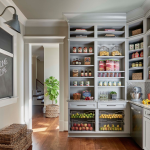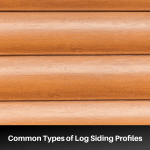Corrugated metal siding is a type of cladding made of thin, rippled metal sheets. The siding is popular for its industrial appearance, durability, and resistance to harsh weather conditions. It suits residential and commercial properties in areas that experience extreme weather conditions.

Pros and Cons of Corrugated Metal Siding
Pros
- Low maintenance: Corrugated metal siding doesn’t need painting, sealing, or staining like other siding materials.
- Modern and industrial look: Its sleek and industrial aesthetic is best for contemporary homes and structures.
- Durability: The siding option withstands weather conditions like wind, snow, or hail. It also has a high resistance to fire and pest infestations.
- Weather resistance: Corrugated metal siding isn’t prone to water damage. It’s ideal for areas with high precipitation levels.
Cons
- Cost: Corrugated metal siding is pricier than other options, such as wood or vinyl. Its weight and structural requirements also make the installation cost more expensive.
- Noise pollution during rain or hail: The siding produces a lot of noise during rain or hail storms due to the material’s thinness and rigidity.
How to Install Corrugated Metal Siding
Gather the necessary tools and materials to install corrugated metal siding.
Tools and Materials Required
- Corrugated metal panels
- Furring strips
- Screws
- Drill with screwdriver bit
- Saw for cutting the metal panels
- Measuring tape
- Level
- Safety equipment, such as gloves and safety glasses
Step-by-Step Installation Process
- Prepare the surface: The surface should be clean and debris-free before installing the corrugated metal siding. It helps ensure that the siding adheres to the surface and lasts longer.
- Install the furring strips: Install vertical furring strips two feet apart. Besides allowing air circulation, the strips provide a surface to which the panels will attach.
- Cut and install the panels: Measure the length and height of each wall and cut the panels to size. Cut the panels with precision to ensure a perfect fit. Align the first panel from the bottom of the wall using furring strips. Secure it with screws, then repeat the process with the remaining panels, ensuring a uniform overlap.
- Secure the panels with screws: Use screws with rubber gaskets to attach the panels to the furring strips. It prevents water from seeping through the screw holes and causing damage to the siding.
- Install the trim pieces: Install the trim pieces to complement the siding’s look. It also helps keep water out and prevents wind damage.
Cost of Corrugated Metal Siding
The cost of corrugated metal siding varies depending on various factors. Installing corrugated metal siding costs between $3 and $8 per square foot. The average installation cost is around $5 per square foot.
Factors Affecting the Overall Cost
- Type of metal: The type of metal affects the overall cost. Common metal types include copper, steel, and aluminum. Each metal has its perks and properties, some pricier than others. For example, copper is more expensive than steel but more durable.
- Quality and thickness: High-quality metal is more expensive but lasts longer and requires less maintenance. Thicker metal sheets also protect against extreme weather conditions and potential damage.
- Labor costs: The charges vary depending on a project’s complexity and the installer’s skill level.
- Project size and complexity: Large projects need more materials and labor, which can further increase the cost. Projects with more complex designs may also need extra customization.
- Surface preparation and repairs: Extensive wall repairs and surface preparation increase labor costs.
Comparison of Corrugated Metal Siding With Other Siding Options
Vinyl Siding
Vinyl siding is a cheaper alternative and requires less maintenance. It also comes in a broader range of colors and styles. It’s, however, not as durable as corrugated metal siding since it cracks or fades over time.
Wood Siding
Wood siding has a natural and inviting appearance. It comes in various wood types, including cedar, pine, and redwood. Unlike corrugated metal siding, it’s more prone to damage from fire, moisture, and insects.
Fiber Cement Siding
Fiber cement siding is a newer option that offers low maintenance and durability. It’s resistant to moisture, fire, and insects. But, the siding option is more expensive than corrugated metal siding.
Stone Siding
For a classic and elegant look, consider stone siding. Stone siding offers a high-end look to your home. While it’s also durable and fire-resistant, stone siding is one of the most expensive options. It’s heavy, affecting your home’s foundation, and requires professional installation.
Common Corrugated Metal Siding Materials
Corrugated metal siding materials include steel, zinc, copper, and aluminum.
Steel
Steel is suitable for corrugated metal siding due to its durability and affordability. It’s available in various finishes, such as galvanized, galvalume, and painted.
Aluminum
Aluminum is lightweight, durable, and corrosion-resistant. Corrugated metal siding made of aluminum is ideal for areas with high moisture or sea spray.
Copper
Copper is a high-end material with a unique appearance and outstanding durability. It’s also corrosion-resistant, making it a suitable siding material for homes in coastal areas.
Zinc
Consider corrugated metal siding made from zinc if you want a natural look. Zinc is also corrosion-resistant and requires minimal maintenance.
Uses and Applications of Corrugated Metal Siding
Corrugated metal siding has various uses and applications across many settings.
Residential Homes
The siding type adds a modern and industrial feel to residential homes. It’s often used as an accent wall, an exterior cladding option, or a roofing material. Homeowners choose corrugated metal siding for its low maintenance, durability, and energy efficiency.
Commercial Buildings
Retail stores, restaurants, and warehouses often use corrugated metal siding. It’s available in various durable materials, making it ideal for high-traffic areas. The siding’s modern look also enhances the aesthetics of a commercial building.
Agricultural Buildings
Corrugated metal siding is suitable for agricultural structures such as barns and sheds. Its durability makes it ideal for an agricultural setting.
The post Corrugated Metal Siding: Design Options, Installation, and Cost appeared first on Homedit.



